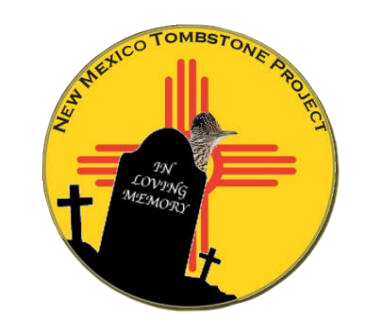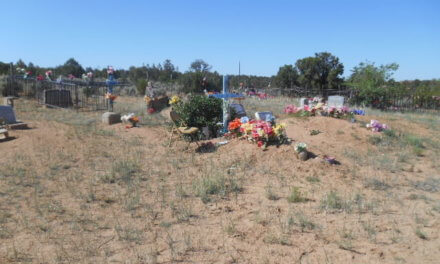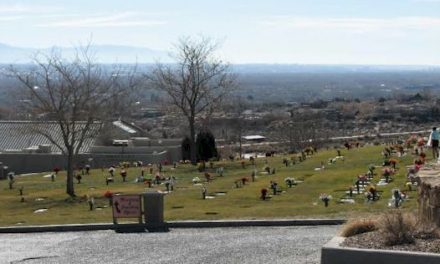Cooper Ellis Ranch Cemetery, Las Huertas, Sandoval County, New Mexico
Remembering Bob Cooper
On May 27, (2011) long-time member Robert Williams “Bob” Cooper died at his home in Cedar Crest. There was no funeral service, and Bob’s cremains were to be buried in the Cooper-Ellis family cemetery in Las Huertas Canyon in the North Sandias in a private ceremony. Bob knew well the history of the mountains and Albuquerque, and shared that knowledge on Feb. 26, 2000. The story that appeared in the EMHS spring 2000 newsletter (which is not on our website) is reprinted here for the benefit of those who missed that wonderful lecture.
Long-Time Resident Holds Audience Spellbound
By Denise Tessier
Two hours fly by when one-time history teacher, ski area “snow ranger” and longtime mountain man Bob Cooper starts talking about East Mountain history. During a well-attended talk hosted by the East Mountain Historical Society Feb. 26, Cooper gave an overview of the area’s most recent century, including both little-known local details and generous excerpts from a paper he had prepared for the New Mexico Historical Society on “The Remarkable Ellis Family,” original owners of the Sandia Mountain ranch on which he has lived every summer for 72 years. Cooper said there is little written or eyewitness evidence of life in the East Mountains, so historians use a lot of qualifiers like “maybe” and “probably.” His own memory goes back to the 1930s, extended by stories he’s collected from the generation before, including Paul Ellis, youngest of the Ellis clan (born in Albuquerque in 1891). A century ago, Cooper said, “life was an isolated, mean, poverty-stricken existence,” with people spread out in numerous villages, farms and ranches. But there “was no government assistance” and people “helped each other… They didn’t consider themselves deprived.” Ever resourceful, they eschewed self-pity “and accepted the life they had.” Most spoke Spanish, and lived in the small villages of Cerrillos, Placitas, San Antonio, Tijeras, Cedro, Carnue, Canoncito, Chilili, Juan Tomas, Punta de Agua, Miera and Escobosa. San Antonito was “founded by unhappy relatives of San Antonio.” At this time, Indian villages were no longer occupied. The few non-Hispanics, including “quite a few Italians,” mostly came to work the mines at Cerrillos, Madrid and in the San Pedro Mountains. In 1880, the population of San Pedro (6,000) was greater than that of Albuquerque (4,500). Cooper remembered that in his boyhood, long after San Pedro’s heyday, people still lived in tents there. At one time the town had 29 saloons and a number of houses of ill repute. In 1879 the Santa Fe Railway was fueled by coal, and at one point, the railroad was scheduled to come to the East Mountains. A roadbed was cleared through Tijeras Canyon and dirt work was done along Frost Road (the train would have traveled northwest to San Pedro Creek, where raised beds can still be seen). At the time, one of the officials of the railroad was named Frost; hence, a legacy was left, even though the tracks were never laid. Health seekers started showing up by 1910. (Cooper’s own grandfather came to Albuquerque dying of tuberculosis, lived another 30 years and founded Presbyterian Hospital). They gravitated toward the mountains, building many of the houses with screened porches found in Cedar Crest, Sandia Park and Mountain air. By the 1920s, the first county schools were started at San Antonito and Tijeras. There were few stores; some residents made a living shooting and dressing game to sell in Albuquerque, to neighbors or in the mining camps. Cooper’s story of the Ellis family was especially fascinating. Having arrived in New Mexico in 1879, George Ellis, wife Julia and mother Eliza Carter Ellis eked out a fairly good living halfway between Vaughn and Encino when their well went dry and they headed to Albuquerque. Working for the Herman Bleuher Gardens (near the present-day Sheraton Old Town), Ellis delivered fruit to the mining camps when he discovered a “steep, deep canyon of extraordinary beauty … (Las Huertas Canyon).” The Ellis family settled in what is now called the Ellis/Cooper Ranch, an area made exceedingly rich by its 37 springs, miles of creek and abundant rain and snowfall. Ninety percent of all the water on the Sandias is found on the piece Ellis patented in 1905. Cooper described in rich detail the lives of the Ellises and their children and the ranch’s abundant animal and plant life. All 480 species of flowering plants found in the Sandias are found on the ranch, including orchids, osha and five colors of columbine. More than 120 varieties of birds have been documented there, including a gray, nondescript water bird called the “oozle.” Cooper says the water oozle walks on the bottom of creeks and ponds, completely submerged, then flies away. He’s seen them in the clear waters of the ranch “nearly every year” since his boyhood, and they’re “very rare.” Hawks, eagles and wild turkeys have returned to the ranch, which is also host to eight varieties of hummingbirds, “more than have been spotted in any one place in New Mexico.” During the Ellis’ 25 years on the ranch, daughter Charlotte kept a journal, in which she recalled hiking several miles to get iron water from a certain spring (for medicinal reasons). Plants from the ranch were shipped to botanical gardens in New York and London. Son August W. Ellis shot the last recorded grizzly bear in the Sandias in 1906. Son Paul was buried in the family plot on the ranch in 1962, on his 89th birthday. Today, 18 to 20 families and the Presbyterian Church own the Ellis/Cooper Ranch. Bob Cooper raises trout there in deep pools of “absolutely clear water, even after a heavy rain.”
Children of George Ellis and Lydia Shipman:
- Guy Carter Ellis born 9/20/1870
- Helen Maude Ellis born 9/6/1872
- Charlotte C. Ellis born 6/27/1874
- Augie Ellis born 1877
- Frank Ellis born 1879
- Paul M. Ellis born 6/15/1891, died in 1962 and was buried in the Cooper Ellis Ranch cemetery.
| Cemetery: | Cooper Ellis Ranch Cemetery |
| GPS: | N 35.22653, W 106.41967 (Not exact) |
| County: | Sandoval |
| Directions: | S of Las Huertas picnic area, SW of Cooper Ellis Ranch from NM 165. |
Cooper Ellis Ranch Cemetery, Las Huertas, Sandoval County, New Mexico
| Surname | Given | Birth | Death | Age | Notes |
|---|---|---|---|---|---|
| Cooper | Bob | 2011 May 27 | See article | ||
| Ellis | George | 1913 Feb | Husband of Julia Shipman Ellis. | ||
| Ellis | Paul | 1891 Jun 15 | 1962 | Son of George and Julia Ellis |






Recent Comments